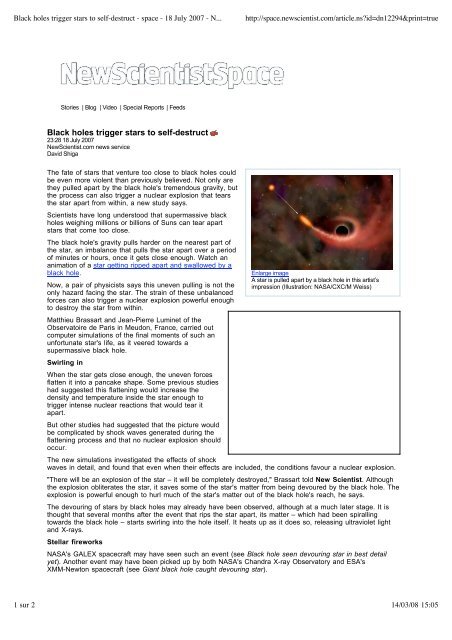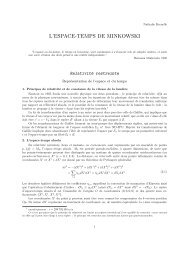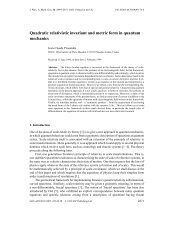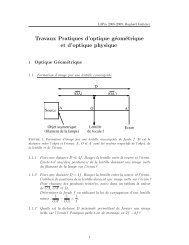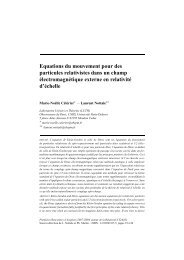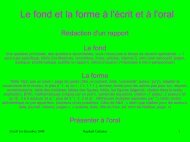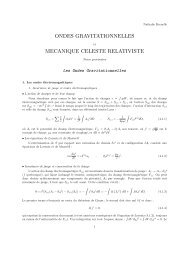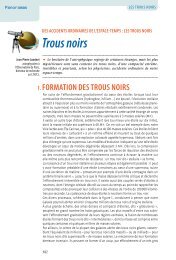Black holes trigger stars to self-destruct - LUTh - Observatoire de Paris
Black holes trigger stars to self-destruct - LUTh - Observatoire de Paris
Black holes trigger stars to self-destruct - LUTh - Observatoire de Paris
You also want an ePaper? Increase the reach of your titles
YUMPU automatically turns print PDFs into web optimized ePapers that Google loves.
<strong>Black</strong> <strong>holes</strong> <strong>trigger</strong> <strong>stars</strong> <strong>to</strong> <strong>self</strong>-<strong><strong>de</strong>struct</strong> - space - 18 July 2007 - N... http://space.newscientist.com/article.ns?id=dn12294&print=true<br />
S<strong>to</strong>ries | Blog | Vi<strong>de</strong>o | Special Reports | Feeds<br />
<strong>Black</strong> <strong>holes</strong> <strong>trigger</strong> <strong>stars</strong> <strong>to</strong> <strong>self</strong>-<strong><strong>de</strong>struct</strong><br />
23:28 18 July 2007<br />
NewScientist.com news service<br />
David Shiga<br />
The fate of <strong>stars</strong> that venture <strong>to</strong>o close <strong>to</strong> black <strong>holes</strong> could<br />
be even more violent than previously believed. Not only are<br />
they pulled apart by the black hole's tremendous gravity, but<br />
the process can also <strong>trigger</strong> a nuclear explosion that tears<br />
the star apart from within, a new study says.<br />
Scientists have long un<strong>de</strong>rs<strong>to</strong>od that supermassive black<br />
<strong>holes</strong> weighing millions or billions of Suns can tear apart<br />
<strong>stars</strong> that come <strong>to</strong>o close.<br />
The black hole's gravity pulls har<strong>de</strong>r on the nearest part of<br />
the star, an imbalance that pulls the star apart over a period<br />
of minutes or hours, once it gets close enough. Watch an<br />
animation of a star getting ripped apart and swallowed by a<br />
black hole.<br />
Now, a pair of physicists says this uneven pulling is not the<br />
only hazard facing the star. The strain of these unbalanced<br />
forces can also <strong>trigger</strong> a nuclear explosion powerful enough<br />
<strong>to</strong> <strong>de</strong>stroy the star from within.<br />
Matthieu Brassart and Jean-Pierre Luminet of the<br />
Observa<strong>to</strong>ire <strong>de</strong> <strong>Paris</strong> in Meudon, France, carried out<br />
computer simulations of the final moments of such an<br />
unfortunate star's life, as it veered <strong>to</strong>wards a<br />
supermassive black hole.<br />
Swirling in<br />
When the star gets close enough, the uneven forces<br />
flatten it in<strong>to</strong> a pancake shape. Some previous studies<br />
had suggested this flattening would increase the<br />
<strong>de</strong>nsity and temperature insi<strong>de</strong> the star enough <strong>to</strong><br />
<strong>trigger</strong> intense nuclear reactions that would tear it<br />
apart.<br />
But other studies had suggested that the picture would<br />
be complicated by shock waves generated during the<br />
flattening process and that no nuclear explosion should<br />
occur.<br />
Enlarge image<br />
A star is pulled apart by a black hole in this artist’s<br />
impression (Illustration: NASA/CXC/M Weiss)<br />
The new simulations investigated the effects of shock<br />
waves in <strong>de</strong>tail, and found that even when their effects are inclu<strong>de</strong>d, the conditions favour a nuclear explosion.<br />
"There will be an explosion of the star – it will be completely <strong>de</strong>stroyed," Brassart <strong>to</strong>ld New Scientist. Although<br />
the explosion obliterates the star, it saves some of the star's matter from being <strong>de</strong>voured by the black hole. The<br />
explosion is powerful enough <strong>to</strong> hurl much of the star's matter out of the black hole's reach, he says.<br />
The <strong>de</strong>vouring of <strong>stars</strong> by black <strong>holes</strong> may already have been observed, although at a much later stage. It is<br />
thought that several months after the event that rips the star apart, its matter – which had been spiralling<br />
<strong>to</strong>wards the black hole – starts swirling in<strong>to</strong> the hole it<strong>self</strong>. It heats up as it does so, releasing ultraviolet light<br />
and X-rays.<br />
Stellar fireworks<br />
NASA's GALEX spacecraft may have seen such an event (see <strong>Black</strong> hole seen <strong>de</strong>vouring star in best <strong>de</strong>tail<br />
yet). Another event may have been picked up by both NASA's Chandra X-ray Observa<strong>to</strong>ry and ESA's<br />
XMM-New<strong>to</strong>n spacecraft (see Giant black hole caught <strong>de</strong>vouring star).<br />
1 sur 2 14/03/08 15:05
<strong>Black</strong> <strong>holes</strong> <strong>trigger</strong> <strong>stars</strong> <strong>to</strong> <strong>self</strong>-<strong><strong>de</strong>struct</strong> - space - 18 July 2007 - N... http://space.newscientist.com/article.ns?id=dn12294&print=true<br />
If <strong>stars</strong> disrupted near black <strong>holes</strong> really do explo<strong>de</strong>, then they could in principle allow these events <strong>to</strong> be<br />
<strong>de</strong>tected at a much earlier stage, says Jules Halpern of Columbia University in New York, US. "It may make it<br />
possible <strong>to</strong> see the disruption of that star immediately if it gets hot enough," he <strong>to</strong>ld New Scientist.<br />
Brassart agrees. "Perhaps it can be observed in the X-rays and gamma rays, but it's something that needs <strong>to</strong><br />
be more studied," he says.<br />
Supernova researcher Chris Fryer of the Los Alamos National Labora<strong>to</strong>ry in Los Alamos, New Mexico, US, says<br />
the <strong>de</strong>aths of these <strong>stars</strong> are difficult <strong>to</strong> simulate, and he is not sure whether the researchers have proven their<br />
case that they explo<strong>de</strong> in the process.<br />
But if these explosions do occur, future observa<strong>to</strong>ries, such as the Large Synoptic Survey Telescope (LSST),<br />
which will <strong>de</strong>tect large numbers of supernovae, could turn up some explosions of this type. "Then these objects<br />
may come in<strong>to</strong> the limelight," he <strong>to</strong>ld New Scientist.<br />
Related Articles<br />
For Milky Way's black hole, it's feast or famine<br />
http://www.newscientist.com/article.ns?id=dn10935<br />
11 January 2007<br />
<strong>Black</strong> hole seen <strong>de</strong>vouring star in best <strong>de</strong>tail yet<br />
http://www.newscientist.com/article.ns?id=dn10736<br />
07 December 2006<br />
Giant black hole caught <strong>de</strong>vouring star<br />
http://www.newscientist.com/article.ns?id=dn4699<br />
18 February 2004<br />
Weblinks<br />
Study abstract<br />
http://arxiv.org/abs/0707.2476<br />
Jules Halpern, Columbia University<br />
http://www.astro.columbia.edu/~jules/<br />
Chris Fryer, LANL<br />
http://qso.lanl.gov/people/fryer/in<strong>de</strong>x.html<br />
Close this window<br />
2 sur 2 14/03/08 15:05


